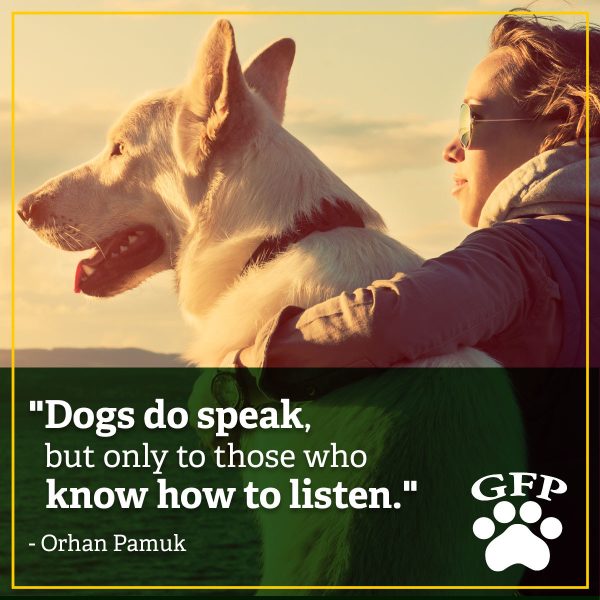16 Types of Dog Body Language to Know

Dogs can’t explain how they’re feeling to you with words. So, if you want to get an idea of what’s going on, you need to pay attention to dog body language and try to figure out what it means for that individual dog.
When it comes to canine body language, there are some general connections you can make with certain positions or actions. But, it’s important to remember that these are generalities and may vary when it comes to an individual dog’s behavior.
You also want to consider body language as a whole and do not necessarily want to rely on one signal in particular. Here are some types of dog body language to know and where to look for them:
Posture
1. Soft or Playful Body Posture
Soft body posture is not tense and often indicates a dog that is feeling relaxed and is one of the signs your dog is happy. A playful dog will often have a soft body posture that is kept loose and is also often full of wiggles. It also tends to be accompanied by lots of exaggerated body movements and facial expressions.
2. Fearful Body Posture
A dog that is feeling fearful can show a variety of postures. They may lean back or away in general or specifically from whatever is causing them stress. They may crouch low to the ground or lower their body.
Fearful dogs may also lower their heads or roll over onto their back or side as a sign of submission. They may also show other signs of fear like trembling, tucking their tail, having wide eyes with dilated pupils, and more.
If a dog is extremely fearful, they could freeze completely in a tense stance or they could run around frantically trying to escape from where they are. If approached, a fearful dog may also defecate or urinate.
3. Aggressive Body Posture
A tense body posture is often paired with other aggressive body language signals. Generally, a dog that is on the defense and putting out an aggressive posture is trying to look as large as possible. They will be standing tensely with their head raised high above their shoulders.
Their weight will be centered or they may lean forward slightly to show they’re ready to defend themselves. Aggressive body posture is also usually paired with other body language signals that say “back off”. These could include growling, a wrinkled muzzle, showing teeth, raised hackles, and a hard eye.
Eyes
4. Seeing More of the “Whites” of Their Eyes
Eye contact with dogs can mean a lot of things. Usually, focused and maintained eye contact can be a sign of aggression or an attempt at asserting dominance. This is why it’s generally not a good idea to maintain direct eye contact when greeting a strange dog.
The white part of the eye is called the sclera. Paying attention to how much of this area you can see can help you determine the intensity and focus of a dog’s gaze. Oftentimes, when a dog is feeling tense, their eyes may look rounder than normal, which can show a lot more of the white around their eyes. This could be a sign of aggression, anxiety, fear, distress, or general stress.
It’s important to consider the dog breed when evaluating a dog’s eyes. Dogs with naturally round eyes may show more of the sclera even when in a relaxed state than dogs with more almond-shaped eyes. Pugs, for example, tend to have rounder, more bulbous eyes. For this dog breed, it may be normal to see more of the sclera. However, you will still see more of it than normal for them when they are tense, scared, or excited.
5. Dilated Pupils or a “Glassy-Eyed” Look
Dilated pupils will often give a dog a “glassy-eyed” look. It can be a sign of arousal or of fear. So, a dog whose pupils are dilated could be feeling frightened, threatened, or stressed.
6. Squinty Eyes
When a dog has squinty eyes or almond-shaped eyes, with no white showing, they are usually in a relaxed state. If they’re comfortable, relaxed, and feeling safe, there’s no need to be on high alert, so they will often let their eyes close a little. This is a key sign that your dog trusts you and feels safe with you. On the other hand, squinty eyes paired with a lot of blinking or rubbing could indicate allergies or another eye irritation.
Mouth
7. Smirking or Smiling
Dogs that are feeling happy and relaxed do not tend to hold tension in their mouth. They may have their mouth open, tongue lolling, or panting slightly. They may even have a slight upturn at the corners of their mouth, which will make them look like they are smirking or smiling.
When looking at this canine body language, also take the weather and temperature into account. Since dogs cool themselves off by panting, a dog may be panting as a function to keep themselves cool instead of an indication that they are relaxed.
Heavy panting paired with drooling or sticky saliva could be heat stroke symptoms and you will want to get the dog cooled off as soon as possible. If heat stroke is underway, you need to get to the vet immediately.
8. Closed Mouth and Drooling
A dog that is keeping their mouth closed could be feeling fearful or tense. They may also pull their lips back a little at the corners while keeping it closed, which will give them a “long-lipped” look.
Rapid panting or closing the mouth after panting normally in response to something can both be indications of a dog feeling increased stress. When a dog that is not prone to drooling begins to drool even when there is no food, it’s a sign that there is something else going on. There are many reasons why dogs drool. In this case, the dog could be feeling stressed or anxious.
9. Showing Teeth
In dogs, showing teeth is usually assumed to be an aggressive move. In many cases, it is. However, seeing teeth does not always mean aggression, so it’s important to take the whole body into account and get context from other areas.
Showing Teeth as a Sign of Aggression
A wrinkled muzzle should be taken as a warning to back off, stay away, or stop what you are doing. A wrinkled muzzle paired with visible teeth is called an “offensive pucker” and is a sure sign to back off.
In this case, the lips are usually pulled up vertically to prominently show a dog’s front teeth. Although it doesn’t always occur, this type of mouth often comes with growling and other signs of tense body language. For example, you’ll likely also see a tense forehead, tense body, and rounder eyes.
Showing Teeth Non-Aggressively
Some dogs will show their teeth as a sign of submission, referred to as a “submissive grin” or “submissive smile”. In this case, the dog is showing their teeth, but it is often paired with friendly and submissive body language signals.
A smiling dog will often also have soft body posture and relaxed, squinty eyes. They usually also lower their head, flatten their ears, and wag their tails. They may even roll over and show you their belly while wagging their tail!
10. Yawning and Licking Lips
Dogs yawn when they are relaxed, but yawning can also be an early sign of distress or increased stress. These are also reasons why dogs sigh. Stress, discomfort, or distress are particularly true when a dog is yawning, licking their lips, and holding a tight mouth. They may also emit whining sounds. All of these signs indicate increased stress or discomfort.
Ears
11. Flattened Ears
Where the base of the ear is pointing can help you figure out what a dog is trying to say, especially when paired with other canine body language signals.
Ears that are flattened straight back, where the base of the ear is pointed to the back, can either be aggressive or submissive. You’ll have to rely on other signals to determine which one. One of the biggest indicators is whether the overall body posture is tense or soft.
A relaxed body posture with flattened ears usually also shows other relaxed or submissive body language signals. On the other hand, a tense body posture with flattened ears usually also shows other tense body language that signals anxiety, stress, or aggression.
12. Ears Slightly Back or to the Sides
When the base of the ear is slightly back or to the sides, it’s often a sign of relaxed ears. Usually, this also indicates a relaxed dog as well.
13. Ears Forward
If the base of the ears is forward, a dog’s ears will be perked up and pointed toward whatever they are interested in. If they are really interested, their foreheads will often wrinkle a little as well. Dogs may sit up like a human to see things better if they are interested in something.
“Interest” can be vague, so you’ll want to look at other body language to determine how things are going. A dog can show interest in something or someone and could end up feeling relaxed, submissive, anxious, or aggressive. The other body language signals they start to show can help you figure it out.
Tail
14. Relaxed Tail
A dog that is feeling relaxed tends to hold their tail in a neutral position when standing. It extends out naturally from the spine and is held in-line or below spine level.
15. Excited Tail
As a dog starts to get more excited, they’ll often raise their tail above spine level. And, of course, they’ll start wagging it and may also exhibit the adorable “butt wiggle”. Excitement can even be one of the reasons why dogs shake.
An excited tail could be wagging loosely from side to side slowly, it could be wagging in a fast circular sweep, or it could be rapidly moving from side to side in short movements. It all depends on how excited the dog is and what type of tail they have!
16. Fearful Tail
Dogs that are feeling fearful, stressed, or anxious tend to tuck their tail between their legs. They may hold the tail against the belly without moving it or they may hold it tucked in while wagging the end stiffly. This is why one of the common dog myths is that wagging tail means a dog is happy. It often is, but not always and it’s important to look at what else they are doing.
Some dogs may also use the “tuck and wag” move as a submissive gesture. It’s important to take other body language signals into account to figure out how the dog is feeling and what they’re trying to convey to you.
Dogs have emotions, and although humans and dogs share some of the same emotions, there are different communication styles. It’s important to understand canine body language for better interactions with your dog and with other dogs.
Knowing these types of dog body language and what they can mean can help you communicate better with your own dog and even understand how to interact, or not interact, with other dogs. This is also one of the tips for helping your shy dog interact with other dogs & people.
Check out the infographic from Off-Leash Hotel below for a visual guide to common canine body language. Click to view at full size.


